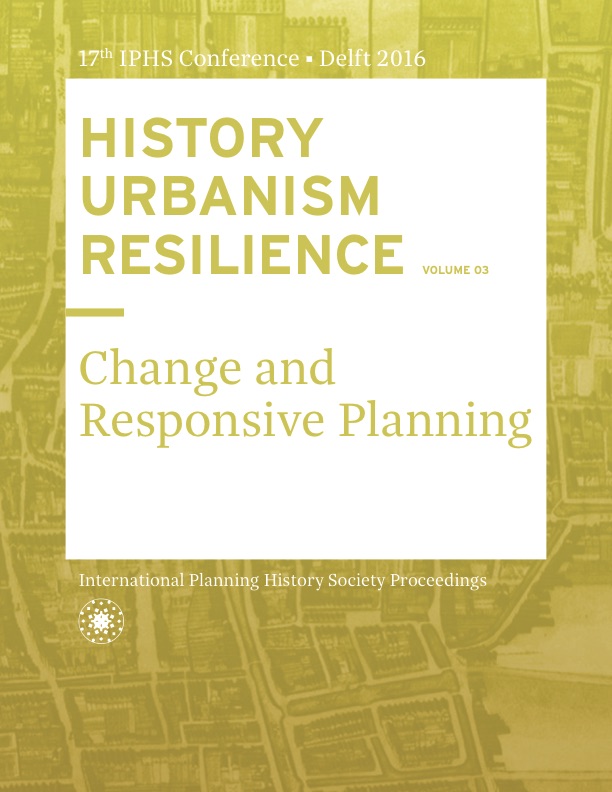The “Venezia Nuova” district in Livorno, Italy. The role of the Dominicans in the urban development of the city.
DOI:
https://doi.org/10.7480/iphs.2016.3.1256Abstract
The paper intends to analyse, through a study of the Domenican convent in Livorno, the urban development of this Tuscan city, from the 17th century, when the Friars Preachers established there permanently.The city of Livorno was founded by the Medici family in the 16th century, using the Bernardo Buontalenti project for a newly fortified urban center.
The Dominicans reached Livorno, which was a maritime trading center, and obtained from the Grand Duke Cosimo III, in 1695, a land in an expanding area, the “Venezia Nuova” (New Venice) in order to build their convent. In this part of the city the Dominicans found an urban structure which was particularly appealing to their religious activities and their desire to expand. Indeed, this area had developed in order to suit the merchant class needs. However, this commercial aspect was disdained by the Dominicans, as it was associated with the ultimate sin, i.e. usury.
This research intends to deepen our knowledge, through examining ancient maps and drawings of the Dominican complex project, of a less known Livorno’s history aspect. Specifically, it aims to investigate the planning strategy of “Venezia Nuova” urban area, which was established in the 17th century in order to welcome the Order of Preachers. At that time the city was experiencing a great economic and social increase, and the presence of the Dominicans would determine the 18th-century urban expansion. The area was a particular land characterized by the presence of the sea and some marshes, and, through architectural and constructive expedients, it was adapted to the project needs. Indeed, the new development was conceived as an island surrounded by canals dug out from old military moats. The canals were designed to have ports and landing places, in order to facilitate a rapid flow within the city for the loading and unloading of goods.
After the suppression of the Dominican convent, this complex was assigned to the Ecclesiastical administration. In 1786 it experienced several functional and architectural transformations; successively, during the French dominion (1808-1814), the structure was turned into a prison. Until a few decades ago it continued to be used as a jail, and this usage caused the abandonment of the religious structures and a general decay in this section of the city.
A recent restoration and consolidation intervention on the ex-Dominican convent, which aim was the transformation of the edifices into a new site for the State Archives, gave the opportunity to know the religious complex. It had suffered heavy architectural and functional changes that had a significant importance in the urban context as well.
Nowadays, despite experiencing a state of abandonment and decay, the area still provides interesting points of force and great potential, deriving from a perfect synergy between architecture, urban environment and the city. This potential and the “value” relationships need to be recovered in a future project that will reinterpret the site and foster retrieving both the functional use and the valorisation of the architecture within the entire urban center.
References
Bandi per il popolamento di Livorno, 1590-1603, Introductions by Lucia Frattarelli Fischer, Paolo Castignoli. Livorno: Cooperativa Risorgimento, 1988.
Bevilacqua, Mario. Architetti e costruttori del Barocco in Toscana, in Architetti e costruttori del Barocco in Toscana opere, tecniche, materiali, edited by Mario Bevilacqua. Roma: De Luca Editori d’Arte, 2010.
Burigana, Riccardo. “Troppa tolleranza”? La ri-fondazione della città di Livorno (1606), Revista de Teologia e Ciências da Religião, 5, 1, dezembro 2015. Recife: REV. TEO&CR, 2015.
Ceccarini, Stefano. La Nazione armena e la chiesa di S. Gregorio Illuminatore. Parte prima, Il Pentagono. Bollettino dell’Associazione LEGBLU.
Ceccarini, Stefano. La Venezia Nuova. Parte prima, Il Pentagono. Bollettino dell’Associazione LEGBLU.
Conforto, Maria Luisa, Frattarelli Fischer, Lucia. Dalla Livorno dei Granduchi alla Livorno dei mercanti. Città e proprietà immobiliare fra ‘500 e ‘600, Bollettino Storico Pisano, LIII, 1984.
Errico, Clara, Montanelli, Michele. La confraternita di Santa Caterina da Siena presso i PP. Predicatori, Quaderni del Museo di Storia naturale del Mediterraneo. Livorno. Series Proceedings, 3, November 2000. Livorno: ed. Benvenuti e Cavaciocchi, 2000.
Labat, Jean Baptiste. Voyages du P. Labat de l’ordre des FF. precheurs en Espagne et en Italie. Amsterdam: Aux dépens de la Compagnie, 1731.
Montfaucon, de, Bernard. Diarium italicum Sive Monumentorum Veterum, Bibliothecarum Musæorum, &c. Notitiæ singulares in Itinerario Italico collectæ: Additis schematibus ac figuris. Parisiis: apud Joannem Anisson, 1702.
Passerin D’Entreves, Ettore. La riforma “giansenista” della Chiesa e la lotta anticuriale in Italia nella seconda metà del Settecento, Rivista storica italiana, LXXI, 1959.
Tabarrini, Marisa. Bernini e Borromini: consulenze per l’ampliamento di palazzo Medici Riccardi a Firenze, in Architetti e costruttori del Barocco in Toscana opere, tecniche, materiali, edited by Mario Bevilacqua. Roma: De Luca Editori d’Arte, 2010.
Ultimieri, Davide. Livorno descritta dai viaggiatori francesi (1494-1836). Livorno: L’informazione, 2000.
Vivoli, Giuseppe. Annali di Livorno. Dalla sua origine sino all’anno di Gesù Cristo 1840, t. IV. Livorno: Sardi, 1842-1846.

